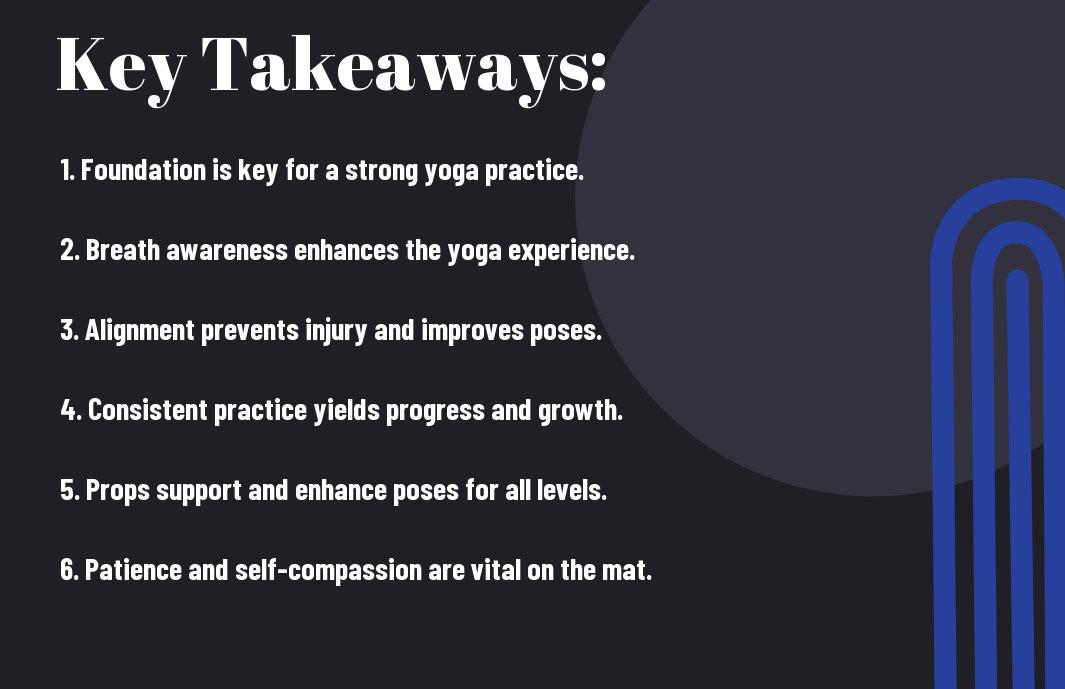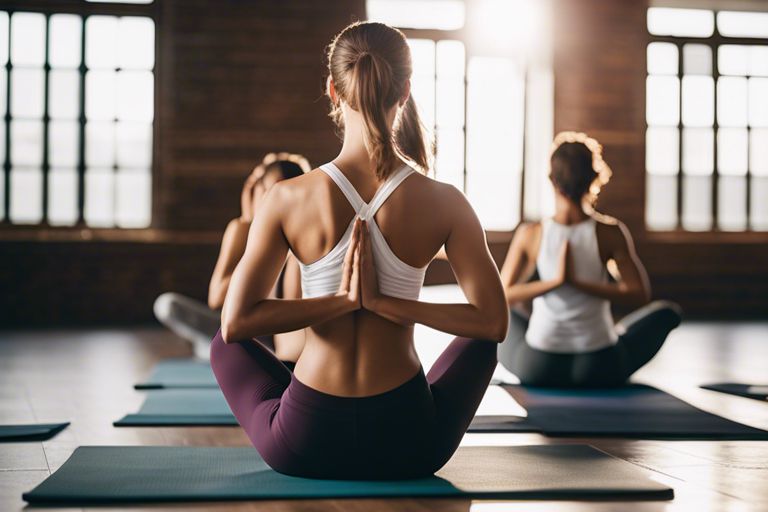Most people are familiar with the term yoga, but few truly understand its foundational principles and practices. In this comprehensive guide, we will explore into the basics of yoga, from its origins and philosophy to key poses and breathing techniques. By grasping these fundamentals, you will lay a solid foundation for your yoga practice, enabling you to reap its full benefits both physically and mentally. Whether you are a beginner looking to start your yoga journey or a seasoned practitioner wanting to deepen your understanding, this article will provide you with the necessary knowledge needed to enhance your practice and overall well-being.
Key Takeaways:
- Alignment is key: Proper alignment is crucial in yoga to prevent injuries and maximize the benefits of each pose.
- Focus on breath: Breathing mindfully and syncing breath with movement helps in maintaining concentration and relaxation throughout the practice.
- Build a solid foundation: Mastering the fundamental poses and principles sets a strong basis for a safe and effective yoga practice.

Core Principles of Yoga
Yoga is a practice that encompasses a variety of principles aimed at nurturing both the body and the mind. Understanding these core principles is imperative for laying a solid foundation in your yoga journey. By embodying these principles, you can fully experience the transformative power of yoga.
The Eight Limbs of Yoga
With a history rooted in ancient Indian philosophy, yoga outlines a path for self-discovery and spiritual growth through the Eight Limbs. These Limbs, as outlined in the Yoga Sutras of Patanjali, serve as a guide for living a meaningful and purposeful life. From ethical guidelines to physical postures and meditation practices, each Limb plays a crucial role in the holistic development of an individual.
Practicing the Eight Limbs of Yoga can lead to a harmonious balance between body, mind, and spirit. By incorporating these principles into your daily life, you can cultivate self-discipline, tap into inner wisdom, and ultimately achieve a state of union with the divine.
Understanding Yoga Philosophy and Ethics
Limbs of Yoga investigates into the deeper philosophical and ethical foundations of the practice. Yoga philosophy encompasses concepts such as non-violence, truthfulness, and self-discipline, guiding practitioners towards a more conscious way of living. Ethics in yoga dictate not only how we interact with others but also how we treat ourselves.
Philosophy forms the backbone of yoga, providing a rich tapestry of wisdom that extends beyond the physical postures commonly associated with the practice. By delving into these philosophical teachings, practitioners can deepen their understanding of themselves and the world around them, paving the way for personal growth and spiritual evolution.

Essential Yoga Practices
Your journey into the world of yoga begins with necessary practices that form the foundation of your practice. By understanding and incorporating these fundamental elements, you can establish a strong groundwork for a fulfilling and transformative yoga experience.
An Overview of Asanas (Yoga Postures)
The practice of asanas, or yoga postures, is a central component of yoga. Asanas not only help improve physical strength, flexibility, and balance but also promote mental clarity and emotional well-being. Each posture is designed to target specific areas of the body while also fostering a meditative state of awareness.
By incorporating a variety of asanas into your practice, you can cultivate a sense of mindfulness and presence throughout your yoga journey. Remember to approach each posture with intention and respect for your body’s limitations, gradually advancing as you build strength and flexibility over time.
Pranayama (Breath Control Techniques)
The practice of pranayama, or breath control techniques, plays a vital role in yoga. By focusing on conscious breathing, you can regulate your energy levels, calm the mind, and enhance your overall well-being. Pranayama techniques range from deep breathing exercises to more advanced breath retention practices, each offering unique benefits for the body and mind.
Any yoga practice is incomplete without the integration of pranayama techniques. By incorporating breath control into your routine, you can deepen your yoga practice and explore the profound connection between breath, body, and mind. Stay mindful of your breath throughout your practice, using it as a powerful tool to anchor your awareness in the present moment and cultivate a sense of inner peace.
Preparing for Your Yoga Journey
For those initiateing on their yoga journey, it is important to lay a strong foundation to enhance your practice. Preparation is key to ensuring a fulfilling and rewarding experience on the mat. In this chapter, we will explore how you can set yourself up for success as you begin your yoga journey.
Setting Up Your Practice Space
Setting up a dedicated space for your yoga practice is crucial for creating a conducive environment for your journey. Choose a quiet and clutter-free area where you can place your mat and any props you may need. Consider adding elements like plants, candles, or soothing music to enhance the ambiance and create a sacred space for your practice. Having a consistent and inviting space will help you establish a routine and make it easier to commit to your practice regularly.
Make sure your practice space has good ventilation and is well-lit to ensure a comfortable and safe environment for your yoga practice. Keep your yoga mat clean and free of distractions to help you stay focused and connected during your practice. By setting up a dedicated space that resonates with you, you are not only creating a physical environment but also setting a positive intention for your yoga practice.
Choosing the Right Yoga Style for You
One of the most important decisions you will make on your yoga journey is choosing the right yoga style that aligns with your goals and preferences. With a variety of styles available, such as Hatha, Vinyasa, Ashtanga, and Restorative, it is crucial to explore different styles to find what resonates with you the most. Each style offers unique benefits and focuses, so taking the time to research and try out different classes will help you discover the style that suits you best.
Right fit is crucial when selecting a yoga style as it will determine your overall experience and progress on your journey. Consider factors like your fitness level, flexibility, and any specific health concerns you may have when choosing a style. Consulting with experienced instructors or attending introductory classes can also provide valuable insight into what each style entails and help you make an informed decision for a fulfilling yoga practice.

Navigating Common Challenges
Overcoming Initial Discomfort and Frustration
Keep in mind that starting a yoga practice can sometimes bring about initial discomfort and frustration. It’s normal to feel a bit awkward or overwhelmed as you learn new poses and breathing techniques. Remember that it’s all part of the journey towards greater self-awareness and inner peace.
For best results, approach your practice with an open mind and a sense of curiosity. Instead of getting discouraged by initial challenges, use them as opportunities to learn and grow. Be patient with yourself and trust that with consistent effort, you will gradually build strength, flexibility, and mindfulness.
Progressing Safely and Avoiding Injury
Frustration can arise when you feel the urge to push yourself too hard or compare your progress to others in the class. Remember that yoga is a personal journey, and each individual’s body is unique. It’s important to listen to your body and honor its limitations. Over time, as you develop a deeper understanding of your body and its capabilities, you will be able to progress at your own pace.
For instance, focus on proper alignment in each pose to avoid strain or injury. Take modifications or use props as needed to support your practice. Remember that yoga is not about achieving the perfect pose, but about the journey of self-discovery and self-acceptance. By practicing with mindfulness and awareness, you can prevent injuries and continue to enjoy the benefits of yoga for years to come.
Integrating Yoga into Your Daily Life
Many individuals are drawn to the practice of yoga not only for its physical benefits but also for the sense of inner peace and balance it brings to their lives. Integrating yoga into your daily routine can have a profound impact on your overall well-being. Whether you are a beginner or a seasoned practitioner, finding ways to incorporate yoga off the mat can enhance your practice and enrich your life.
Establishing a Consistent Practice Routine
The key to reaping the full benefits of yoga is establishing a consistent practice routine. Set aside dedicated time each day for your yoga practice, whether it’s in the morning to start your day on a positive note or in the evening to unwind and relax. Consistency is crucial in developing strength, flexibility, and mindfulness. By committing to a regular practice schedule, you not only improve your physical health but also cultivate a sense of discipline and focus that extends beyond your mat.
Start by setting achievable goals for yourself, whether it’s practicing yoga three times a week or incorporating short meditation sessions into your daily routine. Consistency is more important than intensity, so even short sessions can make a difference. Recall, yoga is a journey, not a destination. Embrace the process and be kind to yourself as you establish a sustainable practice routine that works for you.
Mindfulness and Meditation Beyond the Mat
The practice of mindfulness and meditation goes hand in hand with yoga and extends beyond the physical postures. Mindfulness involves being fully present in the moment, cultivating awareness of your thoughts, feelings, and sensations without judgment. Meditation, on the other hand, is a focused practice that helps calm the mind and deepen self-awareness.
An integral part of yoga, mindfulness and meditation can be incorporated into your daily life to promote a sense of peace and clarity. Whether it’s taking a few minutes to focus on your breath during a hectic day at work or practicing gratitude before bed, mindfulness and meditation can help you navigate life’s challenges with ease and grace. By integrating these practices into your daily routine, you can experience a deeper connection to yourself and the world around you.

To wrap up
Conclusively, grasping the fundamentals of yoga is necessary for building a strong foundation in your practice. Understanding the basic principles, poses, and breathing techniques will not only improve your physical strength and flexibility but also enhance your mental clarity and well-being. By incorporating these fundamental aspects into your routine, you can lay the groundwork for a more fulfilling and transformative yoga journey. Bear in mind, consistency and patience are key as you continue to deepen your practice and reap the many benefits that yoga has to offer.
FAQ
Q: What is the importance of understanding the fundamentals in yoga?
A: Understanding the fundamentals in yoga is crucial as it lays the foundation for a safe and effective practice. It helps in building strength, flexibility, and alignment while reducing the risk of injuries.
Q: How often should a beginner practice yoga?
A: Beginners should aim to practice yoga at least 2-3 times a week to build consistency and see progress. It’s important to listen to your body and gradually increase the frequency as you become more comfortable with the practice.
Q: What are some key foundational poses in yoga?
A: Some key foundational poses in yoga include Mountain Pose (Tadasana), Downward Facing Dog (Adho Mukha Svanasana), Warrior I (Virabhadrasana I), and Child’s Pose (Balasana). These poses help in improving posture, strength, and flexibility.
Q: How can one improve their breathing during yoga practice?
A: To improve breathing during yoga, focus on deep diaphragmatic breathing where you inhale and exhale fully through the nose. Incorporating breath awareness in each pose and practicing pranayama techniques can also help enhance breathing patterns.
Q: What should one keep in mind when setting up a home yoga practice?
A: When setting up a home yoga practice, choose a quiet and clutter-free space with good ventilation. Invest in a quality yoga mat, props like blocks and straps, and follow online classes or create a routine that suits your schedule and needs.

